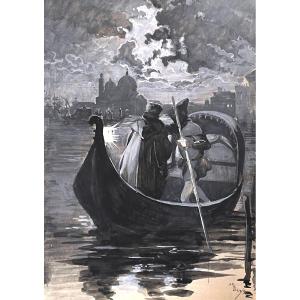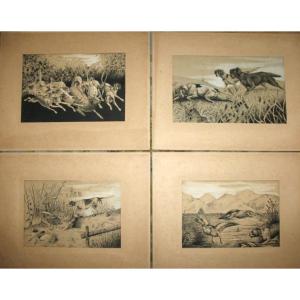Émile Fabry (1865–1966) was a Belgian painter, decorator, and illustrator, best known for giving his Symbolist works a monumental scale. He studied at the Royal Academy of Fine Arts in Brussels, where he was influenced by masters such as Jean-François Portaels.
Fabry became friends with Victor Horta, a great Art Nouveau architect, and collaborated with him on several occasions, notably on the decoration of the Hôtel Solvay. He also worked on murals and stained-glass windows, particularly in public and religious buildings in Belgium. His work embodies the spirit of the Belgian fin-de-siècle, blending decorative art, spirituality, and idealized beauty.
He often combines symbolism, allegories, idealized female figures, and decorative research inspired by Art Nouveau. Very close to Delville and Montald, the three artists would become teachers of his daughter, Suzanne Fabry.
OUR DRAWING
This large red chalk drawing depicts a female face seen from three-quarters, turned slightly to the right, on an almost monumental scale. The background is plain, and the whole point of the drawing lies in the very subtle treatment of the modeling. The almost evanescent rendering gives the figure a spiritual and timeless aura. The fibrous paper holds the red chalk irregularly, allowing for this beautiful ethereal appearance.
The absence of context or setting isolates the model in an indefinite space, removing her from the material world to better evoke an ideal, an archetype rather than a real individual. This impression is reinforced by a feminine face close to classical canons. The calm and meditative gaze, the closed mouth, the softness of the face evoke an inner presence; a portrait of the soul as much as of features.
This female figure could be interpreted as an allegory of beauty, thought, or the soul, in the vein of late 19th-century Belgian Symbolism. It recalls certain figures by Fernand Khnopff or Jean Delville, in their way of evoking the feminine ideal as the incarnation of an inner world rather than an object of desire. Although no link is established between the two artists, our drawing also made us think of certain works by Alexandre Séon.































 Le Magazine de PROANTIC
Le Magazine de PROANTIC TRÉSORS Magazine
TRÉSORS Magazine Rivista Artiquariato
Rivista Artiquariato